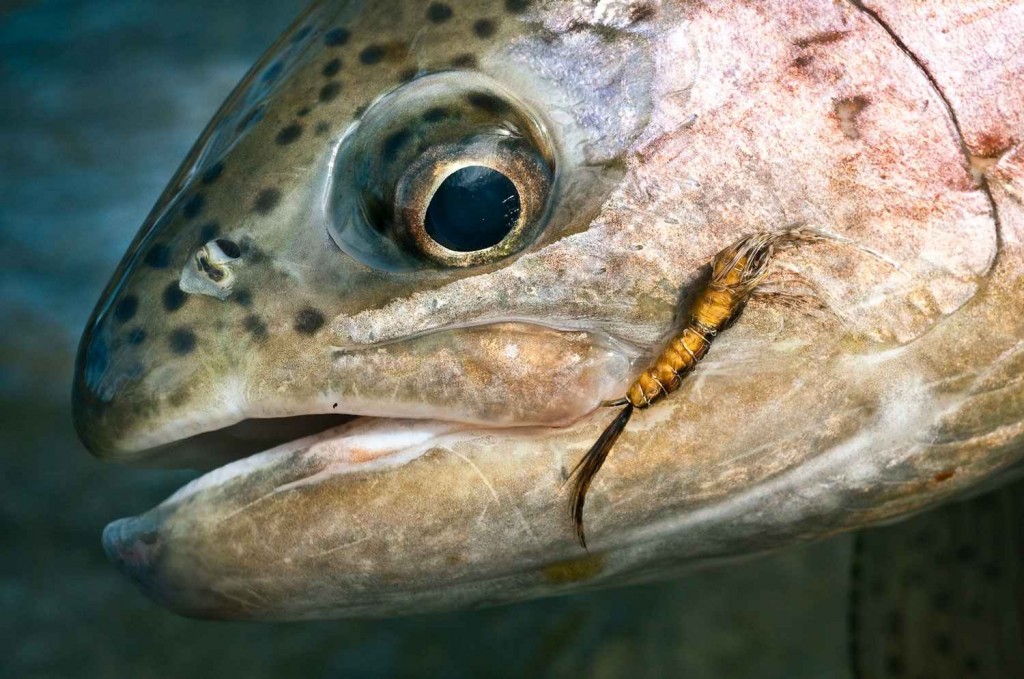
Realistic movement in fly patterns is just as important as having a realistic look. Photo By: Louis Cahill
Worthless may be a little overboard, but there is some truth behind it.
Every year new fly tying products burst onto the scene that are specifically designed for making our fly patterns look extra realistic. I’ll be the first to admit many of them are amazingly cool and innovative. I mean, who wouldn’t want black eyes on their tungsten beads, or a perfect set of pre-molded wing pads or stonefly legs you can plop on a hook to make your nymphs look ultra life-like, right? Seeing these new innovative materials for the first time always gets me giddy, like a fat guy spotting a 5 for 5 deal at Arby’s. But here’s the real question I think we should be asking ourselves. When it comes to purchasing and tying our fly patterns, should we only be focused on how realistic they look?
I say hell no, but you’d be surprised how many fly fishermen out there believe “a realistic look” trumps all other attributes in a fly. Ask a fly shop owner why they carry them if they don’t catch fish, and they’ll quickly tell you, because they sell like hot cakes, that’s why. I think a fly being realistic is great, but there needs to be more working elements in a pattern than just a flashy realistic look. I’ve personally found, that a lot of the time the more realistic you go with fly patterns, the more unrealistic they end up moving and looking in the water. And if they don’t look good in the water, chances are, they’re probably going to be worthless for catching fish. For me, the key to tying and picking out successful fly patterns from the bins over the years has been to always make sure a pattern incorporates equal parts of realistic features and movement. When you can find both in a fly pattern, you’ve got something special.
If you want to get the most out of these new realistic tying materials on the market today, I suggest you compliment them by pairing them up with natural tying materials that have lots of movement in the water. Doing so, you’re flies will both look and move super realistic, and I guarantee you that most fish will find that combination irresistible.
What’s your thoughts?
Keep it Reel,
Kent Klewein Gink & Gasoline www.ginkandgasoline.com hookups@ginkandgasoline.com Sign Up For Our Weekly Newsletter!
Sign Up For Our Weekly Newsletter!

I’m glad many anglers focus on a realistic fly as being the most important characteristic … that leaves more fish for me. If you get close with size, shape (silhouette), and general color (did you ever see all those nymphs under the rock look exactly the same?) but it doesn’t move like the natural (presentation) your fly will get ignored by all but the dumbest (or youngest) fish in the neighborhood. During a hatch, I believe the fish get tunnel vision and the killer fly might seal the deal, but in my experience, it’s the outlier that often gets noticed.
That’s my excuse for catching a lot of fish and I’m sticking to it.
ME and you both. Let them eat realistic cake. I will take movement, over realism, every and I mean EVERY time!
When I started fishing I spent a lot of money on flies designed to catch fishermen, not fish. Still have every one of them too!
Look at bonefish flies now versus 10-15 years ago.
Almost every fly (including those I tie) now sports lifelike mono eyes. They look very shrimpy, every article says they are a “trigger” for fish. (BTW, did someone ask the bones what triggered them?)
I don’t think those eyes matter at all. A Gotcha or Crazy Charlie still works great for bones and a soft hackle is impossible to beat for trout eating emergers yet we persist. It”s all part of the fun and why I carry 1,000 flies with me on the stream yet only fish about 5 patterns.
I have a friend who catches 700 to 900 trout a year on nymphs.
He fishes all the traditional patterns; most do not have much movement and they certainly are not realistic or fancy. His secret: keep adding more split shot until you start hooking trout.
Just look at the heavily weighted nymphs used in Czech style, short line, high-sticking. Those nymphs have almost no moving materials but they get down in the fish’s faces. Not a fan, but those tourney guys vacuum the stream with their de-facto jigs.
Like or not, good nymph fishermen have mastered the art of force feeding fish that will mouth just about anything that is small, dark, and drifts into their wheelhouse.
You all are not complete fly fisherman. No mater how realistic fly pattern looks if your presentation is incorrect in today’s catch and release water fish will refuse your realistic pattern and any other as well.
Dimitri